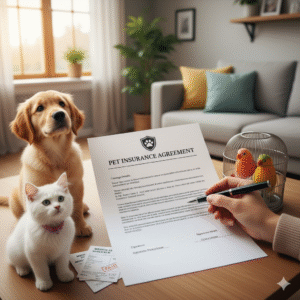Is it worth having pet insurance?

Our pets are more than just animals; they’re family. We celebrate their birthdays, buy them holiday gifts, and let them take up most of the room on our beds. But what happens when that beloved family member gets sick or injured? A few years ago, a friend was faced with a gut-wrenching decision. Her seemingly healthy Golden Retriever, Max, suddenly collapsed. The diagnosis was a torn ACL, a common but expensive injury. The emergency vet quoted her $8,000 for the surgery that would allow Max to walk again without pain. Without that surgery, his quality of life would plummet. She was forced to drain her savings, feeling the immense stress of a financial crisis on top of the emotional turmoil of seeing her best friend in pain.
This scenario is terrifyingly common. As pet owners, we’re faced with a critical question that sits at the intersection of love and finance: Is pet insurance a smart financial safety net or just another monthly bill?
The answer isn’t a simple yes or no. It’s a decision that depends on your financial situation, your pet’s needs, and your personal tolerance for risk. This guide will provide a comprehensive, easy-to-understand deep dive into the world of pet insurance, helping you make an informed choice that protects both your furry friend and your wallet.
Understanding the Rising Tide: Why Are Vet Bills So Expensive in 2025?

If you’ve visited a veterinarian recently, you’ve likely noticed that the costs are not what they used to be. According to the Bureau of Labor Statistics, the cost of veterinary services has been steadily climbing, often outpacing inflation. But why? The primary reason is the incredible advancement in veterinary medicine.
The quality of care available for our pets now rivals human healthcare in many areas. Vets can now perform complex procedures that were unimaginable just a decade or two ago. This includes:
- Advanced Diagnostics: Tools like MRIs, CT scans, and ultrasounds allow for incredibly precise diagnoses of injuries and illnesses.
- Specialized Surgeries: From intricate joint replacements and neurological procedures to life-saving cancer surgeries, veterinary surgeons can work miracles.
- Sophisticated Treatments: Oncology (cancer treatment), cardiology, and internal medicine for pets are now highly advanced fields, offering chemotherapy, radiation, and complex drug therapies.
This high level of care is fantastic news for our pets’ longevity and quality of life. A diagnosis that was once a death sentence might now be a manageable chronic condition. However, this progress comes at a steep price. An MRI can cost upwards of $2,500, a cancer treatment regimen can easily exceed $10,000, and emergency surgery for an intestinal blockage can run $5,000 or more.
It is this new reality of high-cost, high-quality care that makes the financial backstop of pet insurance more relevant than ever. It provides a way to budget for the unexpected and ensure you can always say “yes” to the best possible care for your companion.
Pet Insurance 101: Decoding the Different Types of Coverage
Navigating the world of pet insurance can feel overwhelming at first, with its unique terminology and plan structures. However, most policies fall into a few key categories. Think of it like buying car insurance—you can choose basic liability or opt for full, comprehensive coverage.
1. Accident-Only Plans
This is the most basic and affordable type of pet insurance. As the name suggests, it only covers costs related to unexpected accidents and injuries.
- What’s Covered: Broken bones, toxin ingestion, cuts and lacerations, injuries from a car accident, or swallowing a foreign object.
- Who It’s Best For: Pet owners on a tight budget who want a safety net for major, unforeseen catastrophes. It’s also a common option for older pets who may no longer qualify for more comprehensive illness coverage.
2. Accident and Illness Plans
This is the most popular and widely recommended type of pet insurance. It offers a broad range of protection against both unexpected injuries and a wide variety of sicknesses.
- What’s Covered: Everything in an accident-only plan, plus illnesses like cancer, diabetes, arthritis, infections, digestive issues, skin conditions, and hereditary conditions (provided they aren’t pre-existing).
- Who It’s Best For: The vast majority of pet owners. This plan provides the most comprehensive protection and peace of mind, covering the most common (and expensive) reasons for a vet visit.
3. Comprehensive / Wellness Plans
It’s important to note that this is typically not a standalone policy but an add-on to an accident and illness plan. A wellness plan, sometimes called preventative care, helps offset the costs of routine and preventative treatments.
- What’s Covered: Annual exams, vaccinations, flea, tick, and heartworm prevention, routine blood work, and dental cleanings.
- Is It a Good Value? This is debatable. These plans work on a reimbursement model for a set amount per year. For example, the plan might cost you an extra $25 per month ($300/year) and provide a total of $400 in benefits for routine care. If you know you will use all the benefits, it can save you a little money. However, for many, simply budgeting for these predictable annual costs is a better financial strategy.
The Real Cost of Coverage: How Much Will You Actually Pay for Pet Insurance?

The price of a pet insurance policy is not one-size-fits-all. According to the North American Pet Health Insurance Association (NAPHIA), the average monthly premium for an accident and illness plan in 2023 was $56 for dogs and $32 for cats. However, your actual quote will depend on several key factors:
- Your Pet’s Breed: This is one of the biggest factors. Breeds with known genetic predispositions to health problems are more expensive to insure. For example, French Bulldogs are prone to breathing problems, German Shepherds to hip dysplasia, and Cavalier King Charles Spaniels to heart conditions. Consequently, their premiums are higher.
- Your Pet’s Age: The best time to insure your pet is when they are young and healthy. Premiums are significantly lower for puppies and kittens. As your pet ages, the likelihood of illness increases, and so does the cost of insurance.
- Your Location: Veterinary costs vary dramatically across the country. A routine vet visit or emergency surgery in New York City or San Francisco will cost far more than in a small town in the Midwest. Insurance premiums are adjusted to reflect these local costs.
- Your Customization Choices: Most plans allow you to tailor the policy to fit your budget by adjusting three key levers:
- Deductible: This is the amount you pay out-of-pocket before the insurance kicks in, typically ranging from $100 to $1,000 per year. A higher deductible means a lower monthly premium.
- Reimbursement Percentage: This is the percentage of the vet bill the insurance company will pay back after you’ve met your deductible. Common options are 70%, 80%, or 90%. Choosing a higher reimbursement level will increase your premium.
- Annual Limit: This is the maximum amount the insurer will pay out in a single year. Options can range from $5,000 to unlimited. An unlimited plan offers the most protection but comes with the highest premium.
Sample Monthly Premiums for Popular Dog Breeds (Accident & Illness Plan)
| Breed | Average Low | Average High |
| Labrador Retriever | $45 | $75 |
| French Bulldog | $70 | $120 |
| Golden Retriever | $50 | $85 |
| Chihuahua | $30 | $55 |
| Mixed Breed (Medium) | $35 | $60 |
The Financial Payoff: How Pet Insurance Can Save You Thousands
The true value of pet insurance isn’t realized during a routine check-up; it’s when disaster strikes. It’s the financial tool that allows you to make decisions based on your veterinarian’s advice, not on the daunting numbers on a treatment estimate.
Consider these real-world scenarios:
- Scenario 1: The Swallowed Sock. A young Labrador swallows a sock, causing an intestinal blockage. Emergency surgery is required. Total Cost: $6,000. With a policy featuring a $500 deductible and 90% reimbursement, your out-of-pocket cost would be $500 (deductible) + $550 (your 10% share) = **$1,050**. The insurance covers the remaining $4,950.
- Scenario 2: The Cancer Diagnosis. A 7-year-old cat is diagnosed with lymphoma. The treatment plan includes chemotherapy and regular monitoring. Total Cost over one year: $12,000. With the same policy, your out-of-pocket cost would be $500 (deductible) + $1,150 (your 10% share) = **$1,650**. The insurance covers $10,350.
The process is straightforward. In most cases, you pay your veterinarian directly at the time of service. You then submit the paid invoice and a claim form to your insurance provider through their website or mobile app. Within a few days or weeks, they process the claim and send you a reimbursement check or direct deposit based on the terms of your policy.
Beyond the numbers, the most significant benefit is peace of mind. Pet insurance removes the agonizing choice between your pet’s life and your financial stability, a decision no owner should ever have to make.
Buyer Beware: What’s Hiding in the Fine Print of Pet Insurance Policies?
To be a savvy consumer, you must understand what pet insurance doesn’t cover. Reading the full policy documents before you buy is essential. Here are the most common limitations and exclusions to watch for:
Pre-existing Conditions
This is the single most important exclusion to understand. A pre-existing condition is any illness or injury that your pet showed signs of, was diagnosed with, or was treated for before your policy’s start date and waiting periods have passed. This is why it is so crucial to insure your pet while they are young and have a clean bill of health. An ear infection they had a year before you got insurance will likely mean that future ear infections are not covered.
Some providers distinguish between “curable” (e.g., a respiratory infection) and “incurable” (e.g., diabetes, arthritis) conditions, and may offer coverage for a curable condition if the pet remains symptom-free for a specific period (like 12 or 18 months).
Waiting Periods
You cannot buy a policy today and make a claim tomorrow. All insurers have waiting periods to prevent fraud. These typically are:
- Accidents: 1-3 days
- Illnesses: 14-30 days
- Orthopedic Issues (e.g., ACL tears, hip dysplasia): 6-12 months
If a condition arises during this waiting period, it will be considered pre-existing and permanently excluded from coverage.
Other Common Exclusions
Most standard policies will not cover:
- Breeding, whelping, or pregnancy-related costs.
- Cosmetic or elective procedures (e.g., tail docking, ear cropping, declawing).
- Prescription diets (though some plans offer partial coverage as an add-on).
- Experimental treatments or therapies.
- Behavioral modification therapy (unless specifically included or added on).
Is Pet Insurance a Good Bet for Your Senior Pet?

This is a common and complex question. Insuring a senior pet (typically defined as 7+ years old) has distinct pros and cons.
- The Pros: Older pets are statistically far more likely to develop expensive, chronic conditions like kidney disease, cancer, heart problems, and arthritis. Having insurance can provide immense financial relief when these issues inevitably arise.
- The Cons: The premiums will be significantly higher than for a young pet. More importantly, it is highly likely your senior pet already has a list of pre-existing conditions in their vet records that will be excluded from coverage, potentially limiting the policy’s usefulness.
The Verdict: If your older pet has a relatively clean medical history, getting a policy can still be a very wise move. However, you must go in with realistic expectations and a clear understanding of what will and won’t be covered based on their past health.
The Smart Way to Shop: A Step-by-Step Guide to Choosing the Best Policy
Ready to explore your options? Don’t just pick the first provider you see. Follow these steps to find the best value for your needs.
- Assess Your Pet and Your Finances: Consider your pet’s breed-specific risks. Do you have a breed prone to joint problems? Skin allergies? Also, look at your savings. Could you handle a $3,000 emergency bill tomorrow? What about a $10,000 one?
- Get Multiple Quotes: Use online comparison tools or visit the websites of top-rated providers (like Healthy Paws, Trupanion, Figo, and Pets Best) to get quotes.
- Compare More Than Price: Look at the details. Does the provider cover hereditary and congenital conditions? Do they have per-incident or annual deductibles? What is their policy on bilateral conditions (like ACL tears in both knees)?
- Read Recent Customer Reviews: Check websites like the Better Business Bureau (BBB) and pet owner forums to see what real customers are saying about the claim process and customer service. A cheap policy is worthless if the company refuses to pay valid claims.
- Download and Read the Sample Policy: This is the most crucial step. Before you enter your credit card information, read the fine print. Pay close attention to the “Exclusions” and “Definitions” sections. This is the only way to truly know what you are buying.
Beyond Insurance: Are There Cheaper Alternatives for Managing Vet Costs?
Pet insurance is a powerful tool, but it’s not the only one. If premiums aren’t a good fit for your budget, consider these alternatives:
- A Dedicated High-Yield Savings Account: This is the “self-insurance” method. You automatically deposit a set amount—say, $50 to $100 per month—into a savings account earmarked for vet bills. Pro: You keep the money if you never have a major emergency. Con: It can take years to save enough to cover a major catastrophe, leaving you vulnerable in the short term.
- Veterinary Discount Plans: Services like Pet Assure are not insurance. You pay a small monthly fee, and in return, you get a flat discount (usually 25%) on services at participating vets. Pro: Very affordable, no deductibles, and pre-existing conditions are covered. Con: The discount may not be enough for a major surgery, and you are limited to in-network vets.
- Financing Options: A credit card specifically for healthcare, like CareCredit, can be a lifesaver. It allows you to pay for treatment immediately and then pay it off over time, often with an interest-free promotional period. Important: This is a financing tool, not a cost-saving one. You are still responsible for the entire bill.
- Charities and Crowdfunding: In a true crisis, organizations like The Pet Fund or a GoFundMe campaign can provide a last-resort safety net.
So, Should You Get Pet Insurance in 2025?

After weighing the costs, benefits, and complexities, the decision comes down to your personal financial philosophy. Pet insurance is not an investment designed to make you money. It is a risk management tool designed to protect you from catastrophic financial loss.
Pet insurance is likely a great decision for you if:
- You do not have $5,000 – $10,000 in a liquid emergency fund that you are willing to spend on your pet.
- You own a breed that is prone to expensive health problems.
- You want to ensure you can always make medical choices for your pet based purely on their welfare, without cost being the deciding factor.
- You prefer the predictability of a fixed monthly premium over the risk of a sudden, massive vet bill.
You might consider forgoing pet insurance if:
- You have a substantial emergency fund (upwards of $15,000) and are comfortable with the idea of “self-insuring.”
- Your pet is older with numerous pre-existing conditions that would be excluded anyway.
For most American pet owners, the peace of mind and financial protection offered by a solid accident and illness policy provide immense value. It transforms the terrifying question of “Can I afford this?” into the empowering statement, “We’ll do whatever it takes.” And for the family members who greet us at the door with a wagging tail or a happy purr, that certainty is priceless.







